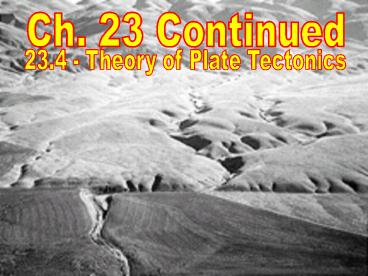Ch. 23 Continued - PowerPoint PPT Presentation
1 / 30
Title:
Ch. 23 Continued
Description:
1. Seismograph - Instrument that detects and measures seismic waves, it prints ... 2. Seismogram - The record of waves produced by seismograph. ... – PowerPoint PPT presentation
Number of Views:41
Avg rating:3.0/5.0
Title: Ch. 23 Continued
1
Ch. 23 Continued
23.4 - Theory of Plate Tectonics
2
Pangaea - The Earths original land mass.
Continental Drift - The process of the Earths
continents drifting over time to form the modern
continents.
3
Review Earths Drifting Continents
A. The Earth once had a single land mass that
broke up into large pieces, that have been
drifting apart ever since.
1. Fossils found on distant continents
suggest they were once connected.
2. Mountains, valleys and mineral evidence
suggest that the continents once fit together
like a jigsaw puzzle.
4
Earths Spreading Ocean Floor
Ocean-floor Spreading - As the ocean floor moves
away on either side of the ridge, lava wells up
and hardens to form new ocean floor.
5
Mid-ocean Ridges - Underwater mountains that have
a deep crack running through their center.
Rift Valley - The crack in mid-ocean ridges.
Mid-ocean ridges form the largest mountain chain
in the world (80,000km long), 20 times the
distance from L.A. to New York.
6
Earths Moving Plates
-Plates - Moving, irregularly shaped slabs that
fit together like paving stones, to form the
surface layer of the Earth.
-Tectonics - The study of movements that shape
the Earths crust.
7
-Theory of Plate Tectonics (Linking the ideas
of ocean-floor spreading and continental drift),
the theory says that Earth has evolved over time
and that this can be explained by understanding
the formation, movements, collisions, and
destruction of the Earths crust.
- Alfred Wegener
8
There are seven major plates The Pacific,
North American, South American, Eurasian,
African, Indo- Australian, and Antarctic.
9
Plate Boundaries (3 types)
1. Divergent - Where two plates are moving
apart.
2. Convergent - Where two plates are colliding.
a. The denser plate is subducted.
b. Oceanic plates tend to be denser than
continental plates.
10
c. When two continental plates (of equal
density) collide, mountain ranges are formed.
11
3. Transform-Fault - When two plates are sliding
horizontally past each other
12
- Convection Currents - The movement of materials
caused by differences in temperature.
1. Convection currents are believed to be the
cause of plate motion.
13
2. Magma close to the core is very hot, magma
farther from the core is cooler and more dense.
3. Gravity pulls harder on the cooler magma,
pulling toward the core. The hotter magma gets
pushed up toward the surface.
4. The hot and cool materials trade places
again and again, this cycle never stops
14
Faults and Folds (Bend or Break)
The crust is under a lot of pressure and strain.
Rocks subjected to stress begin to deform into
folds, and if there is enough stress, they will
break.
Two Types of Folds Anticline - An upward fold in
a rock. (ant hill) Syncline - A downward fold
in a rock (sinning goes down)
15
I. Earthquakes
A. Earthquakes - The shaking and trembling that
result from sudden movements of the Earths crust.
16
C. The most common cause of earthquakes is
faulting.
1. Fault - A crack in the earths crust along
which rocks move.
17
2. Faulting - The process of the Earths crust
moving along a fault, the cause of most
earthquakes.
18
Focus - The point beneath the Earth where rocks
break and move.
Epicenter - The surface point directly above the
focus of an earthquake, where the most violent
shaking occurs.
19
Seismic Waves
1. Seismograph - Instrument that detects and
measures seismic waves, it prints wavy line on
paper.
2. Seismogram - The record of waves produced by
seismograph.
20
3. Seismologist - Scientists that study
earthquakes.
21
4. Richter Scale - Scale used to measure the
relative strength of an earthquake, (scale
ranges 1-10, over 6 is destructive)
22
Volcano - The place in the Earths surface where
magma becomes Lava, the actual hole the magma
exits through.
23
Vent - The opening from which lava erupts.
24
Volcanic Eruptions
25
Volcanic Dust - The smallest rock particles
from an eruption, less than .25mm (like flour)
2. Volcanic Ash - Particles more than .25mm
(like grains of rice)
26
3. Volcanic Bombs - Large rock particles from a
few centimeters to several meters across (from
golf balls to boulders)
4. Cinders - Golf ball size volcanic bombs
27
Types of Volcanoes
28
1. Cinder Cone Volcano - Made of cinders and
other rock particles that have been blown into
the air.
29
2. Shield Volcano - Composed of quiet lava flows
30
3. Composite Volcano - Built up of alternating
layers of rock particles and lava.































